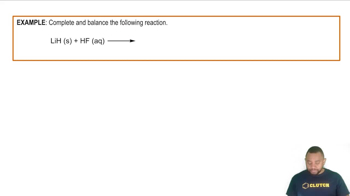A solution of Na2SO4 is added dropwise to a solution that is 0.010 M in Ba2+(aq) and 0.010 M in Sr2+(aq). (a) What concentration of SO42- is necessary to begin precipitation? (Neglect volume changes. BaSO4: Ksp = 1.1⨉10-10; SrSO4: Ksp = 3.2⨉10-7.)

A solution contains three anions with the following concentrations: 0.20 M CrO4^2-, 0.10 M CO3^2-, and 0.010 M Cl-. If a dilute AgNO3 solution is slowly added to the solution, what is the first compound to precipitate: Ag2CrO4 (Ksp = 1.2 * 10^-12), Ag2CO3 (Ksp = 8.1 * 10^-12), or AgCl (Ksp = 1.8 * 10^-10)?
 Verified step by step guidance
Verified step by step guidanceKey Concepts
Solubility Product Constant (Ksp)

Precipitation Reaction

Ion Product (Q)

A solution of Na2SO4 is added dropwise to a solution that is 0.010 M in Ba2+(aq) and 0.010 M in Sr2+(aq). (b) Which cation precipitates first?
A solution of Na2SO4 is added dropwise to a solution that is 0.010 M in Ba2+(aq) and 0.010 M in Sr2+(aq). (c) What is the concentration of SO42-(aq) when the second cation begins to precipitate?
A solution containing several metal ions is treated with dilute HCl; no precipitate forms. The pH is adjusted to about 1, and H2S is bubbled through. Again, no precipitate forms. The pH of the solution is then adjusted to about 8. Again, H2S is bubbled through. This time a precipitate forms. The filtrate from this solution is treated with (NH4)2HPO4. No precipitate forms. Which of these metal cations are either possibly present or definitely absent: Al3+, Na+, Ag+, Mg2+?
In the course of various qualitative analysis procedures, the following mixtures are encountered: (a) Zn2+ and Cd2+. (b) Cr(OH)3 and Fe(OH)3 Suggest how each mixture might be separated.
